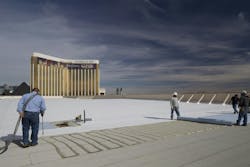Examining Fully Adhered and Mechanically Fastened Membranes for Vegetative Roofing Systems
Which is best for a vegetated roof, a mechanically attached or fully adhered roofing membrane? The same membrane material can have different performance characteristics and costs, depending on how it is secured to the roof. There is a split in the roofing world, in general, over which method is best, but for green roofs, some of these issues have more or less importance. Consider that a vegetated roof system must be well-integrated in order for all the elements to perform properly together. For this goal, a complete single-sourced system may be the best choice to achieve both performance and security.
In a mechanically attached application, the membrane is screwed down to the roof deck every 12 inches along one edge, with round plates under the screw-heads that spread the load. The screws go through whatever layers are between the membrane and the structural deck (air barrier, insulation, cover board) for attachment to the structural surface beneath.
In a fully adhered system, the membrane is glued down to the surface below it by spreading a special adhesive over the entire surface. Sub-layers must be firmly attached to the structural deck, either by mechanical fasteners or appropriate adhesives. In both mechanically fastened and fully adhered systems, the overlapped edges of the membrane are welded with an air heater to seal the membrane system.
Mechanically fastened systems used to enjoy an installation advantage in the winter, as the adhesives for fully adhered systems didn’t like colder weather. But companies are now developing adhesives that makes it possible to install fully adhered roofs down to 20ºF, which levels the playing field.
One study found that in extreme wind events (specifically, Hurricane Katrina), mechanically attached systems resisted peeling very well. However, on a vegetated roof, either system would be protected: the edge of the roof (where peeling begins) is usually protected by a parapet, and the weight of the plants, the planting system, and the water that it retains would hold down most of the membrane (unless the storm blows the entire vegetative system off the roof.) In either type of installation, if the edge of the roof is exposed to wind, a peel-stop can be installed within 12 inches of the edge to limit any possible peeling damage.
A common disadvantage of mechanically fastened membranes stems from the fact that the membrane is loose across most of its expanse, and can flap up and down in the wind. However, in a built-in-place vegetated roof, the layers of the planting system would prevent flapping.
With either attachment method, the best way to ensure that the membrane performs properly and is at minimum risk is to install a completely integrated vegetative roof system and use a single source for these roofing elements. When all elements have been engineered to function together and tested in that configuration to verify performance, an owner can have confidence that the roof will be both high performing and durable. If the roof system is assembled or installed from a variety of sources, the products selected may or may not function well in conjunction with each other. Even if they have each been tested and meet the appropriate standards, the “system performance” hasn’t been tested, and the owner’s roof may have to function as the system test. A fully integrated package or pre=grown modular system eliminates the untested factor. Single sourcing the vegetative roof adds in a layer of confidence with all the sustainable benefits of a green roof.
